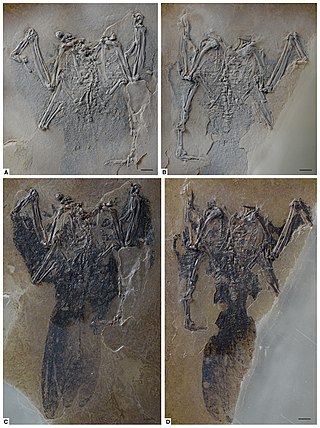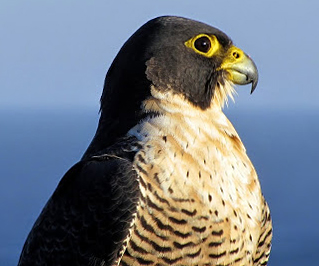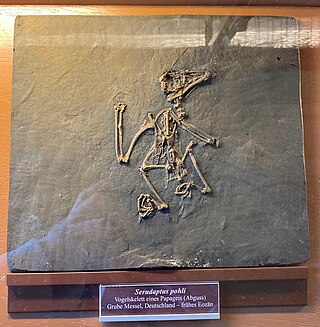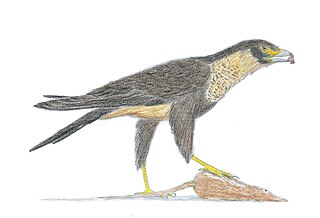
Plotopteridae is an extinct family of flightless seabirds with uncertain placement, generally considered as member of order Suliformes. They exhibited remarkable convergent evolution with the penguins, particularly with the now extinct giant penguins. That they lived in the North Pacific, the other side of the world from the penguins, has led to them being described at times as the Northern Hemisphere's penguins, though they were not closely related. More recent studies have shown, however, that the shoulder-girdle, forelimb and sternum of plotopterids differ significantly from those of penguins, so comparisons in terms of function may not be entirely accurate. Plotopterids are regarded as closely related to Anhingidae (darters) and Phalacrocoracidae (cormorants). On the other hand, there is a theory that this group may have a common ancestor with penguins due to the similarity of forelimb and brain morphology. However, the endocast morphology of stem group Sphenisciformes differs from both Plotopteridae and modern penguins.

Archaeotrogonidae is a prehistoric bird family known from the Eocene and Oligocene of Europe. They are members of Strisores, and are thought to be closely related to nightjars.

Masillaraptor is an extinct genus of masillaraptorid, a group of primitive falconiforms, from the Middle Eocene Messel Pit, Germany. It is a long-legged relative of the living falcons.
Eurofluvioviridavis is a genus of extinct primitive birds from the Middle Eocene Messel Pit, Germany. It contains a single species, Eurofluvioviridavis robustipes. It is related to Avolatavis and Vastanavis, other members of the family Vastanavidae.

The order Falconiformes is represented by the extant family Falconidae and a handful of enigmatic Paleogene species. Traditionally, the other bird of prey families Cathartidae, Sagittariidae (secretarybird), Pandionidae (ospreys), Accipitridae (hawks) were classified in Falconiformes. A variety of comparative genome analysis published since 2008, however, found that falcons are part of a clade of birds called Australaves, which also includes seriemas, parrots and passerines. Within Australaves falcons are more closely related to the parrot-passerine clade (Psittacopasserae), which together they form the clade Eufalconimorphae. The hawks and vultures occupy a basal branch in the clade Afroaves in their own clade Accipitrimorphae, closer to owls and woodpeckers.

Messelasturidae is an extinct family of birds known from the Eocene of North America and Europe. Their morphology is a mosaic that in some aspects are very similar to modern hawks and falcons, but in others are more similar to parrots. Initially interpreted as stem-owls, more recent studies have suggested a closer relationship to parrots and passerines. Their ecology is enigmatic.
Vastanavidae is an extinct family of birds related to parrots and passerine birds. They are known from fossils from Eocene sites in India, Europe, and North America. The vastanavids resemble parrots and the extinct parrot relative Quercypsitta in their morphology, including the partially zygodactyl foot, in which two toes could face opposite the other two.

Halcyornithidae is an extinct family of telluravian birds thought to be related to the Psittaciformes (parrots), Passeriformes (songbirds), and to the extinct Messelasturidae. Halcyornithids have been found in various Eocene formations in Europe and North America. Widespread and diverse in the Early Eocene of North America and Europe, halcyornithids are not found in locales later than the Middle Eocene. Halcyornithids were small, arboreal birds with zygodactyl feet, with two toes facing forwards and two facing back, a trait shared with other tree-dwelling families of Eocene birds like the Zygodactylidae and the messelasturids. The skull of halcyornithids features a ridge of bone above the eye called the supraorbital process, similar to birds of prey. The relationships of the halcyornithids to other birds remain uncertain. Halcyornithids have been proposed as relatives to owls and as a lineage closer to parrots than to songbirds. Most recently, halcyornithids have been identified as the sister group of the clade including parrots and songbirds. It is also possible that Halcyornithidae is paraphyletic with respect to the Messelasturidae.

Zygodactylidae is a family of extinct birds found in Europe and North America from the Eocene epoch to the Middle Miocene. First named in 1971, based on fragmentary remains of two species from Germany, a more complete description of the birds became possible in 2008 when a number of other, better-preserved fossil species were assigned to the family based on a number of shared characteristics.
Morsoravis is an extinct genus of neoavian bird from the Early Eocene Fur Formation of Denmark. It contains a single named species, Morsoravis sedilis. Fossils of Morsoravis have also been found in the Green River Formation of Wyoming and possibly the Nanjemoy Formation of Virginia.

Masillaraptoridae is an extinct family of stem-group falconiform birds from the Eocene of Europe. They are noted for their relatively long legs. Two genera have been named: Danielsraptor, from the London Clay of England, and Masillaraptor, from Messel Pit in Germany.
Danielsraptor is an extinct genus of masillaraptorid bird from the Early Eocene (Ypresian) Walton Member of the London Clay Formation in Essex, United Kingdom. The genus contains a single species, D. phorusrhacoides, known from a partial skeleton.

Ypresiglaux is an extinct genus of strigiform bird from the Early Eocene London Clay Formation of Essex, United Kingdom and Nanjemoy Formation of Virginia, United States. The genus contains two species: Y. michaeldanielsi, known from a partial skeleton, and Y. gulottai, known from a distal tarsometatarsus.

Lutavis is an extinct genus of potentially afroavian bird from the Early Eocene London Clay Formation of Essex, United Kingdom. The genus contains a single species, L. platypelvis, known from a partial skeleton.

Psittacomimus is an extinct genus of psittacopedid bird from the Early Eocene London Clay Formation of Essex, United Kingdom. The genus contains a single species, P. eos, known from a partial skeleton.

Minutornis is an extinct genus of parapasserine bird from the Early Eocene London Clay Formation of Essex, United Kingdom. The genus contains a single species, M. primoscenoides, known from a fragmentary skeleton.
Cyrilavis is an extinct genus of halcyornithid bird from the Early Eocene Fossil Butte Member of the Green River Formation, United States. The genus contains two species, Cyrilavis olsoni and Cyrilavis colburnorum.
Pulchrapollia is an extinct genus of halcyornithid bird from the Early Eocene London Clay of Walton-on-the-Naze, United Kingdom and the Nanjemoy Formation of Virginia, United States. The genus contains three species, Pulchrapollia gracilis, Pulchrapollia tenuipes and Pulchrapollia eximia.
Parapsittacopes is an extinct genus of psittacopedid bird from the Early Eocene London Clay, United Kingdom. The genus contains one species, Parapsittacopes bergdahli.
Eofringillirostrum is an extinct species of bird known from the Early Eocene Green River Formation of the Western United States and from the Messel Pit in Germany. The genus contains two species, Eofringillirostrum boudreauxi and Eofringillirostrum parvulum. They are the earliest known fossil birds to have a finch-like beak.










